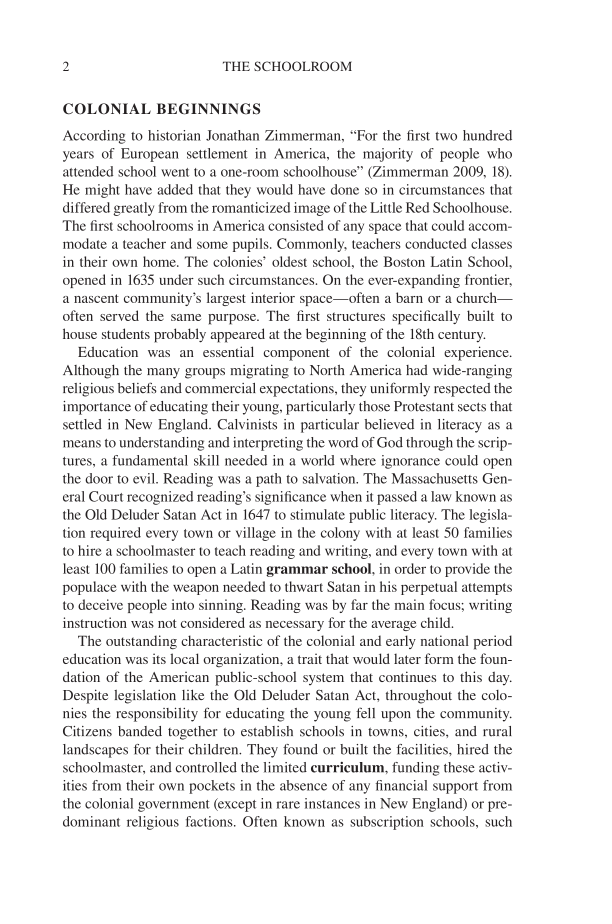THE SCHOOLROOM 2 COLONIAL BEGINNINGS According to historian Jonathan Zimmerman, “For the first two hundred years of European settlement in America, the majority of people who attended school went to a one-room schoolhouse” (Zimmerman 2009, 18). He might have added that they would have done so in circumstances that differed greatly from the romanticized image of the Little Red Schoolhouse. The first schoolrooms in America consisted of any space that could accom- modate a teacher and some pupils. Commonly, teachers conducted classes in their own home. The colonies’ oldest school, the Boston Latin School, opened in 1635 under such circumstances. On the ever-expanding frontier, a nascent community’s largest interior space—often a barn or a church— often served the same purpose. The first structures specifically built to house students probably appeared at the beginning of the 18th century. Education was an essential component of the colonial experience. Although the many groups migrating to North America had wide-ranging religious beliefs and commercial expectations, they uniformly respected the importance of educating their young, particularly those Protestant sects that settled in New England. Calvinists in particular believed in literacy as a means to understanding and interpreting the word of God through the scrip- tures, a fundamental skill needed in a world where ignorance could open the door to evil. Reading was a path to salvation. The Massachusetts Gen- eral Court recognized reading’s significance when it passed a law known as the Old Deluder Satan Act in 1647 to stimulate public literacy. The legisla- tion required every town or village in the colony with at least 50 families to hire a schoolmaster to teach reading and writing, and every town with at least 100 families to open a Latin grammar school, in order to provide the populace with the weapon needed to thwart Satan in his perpetual attempts to deceive people into sinning. Reading was by far the main focus writing instruction was not considered as necessary for the average child. The outstanding characteristic of the colonial and early national period education was its local organization, a trait that would later form the foun- dation of the American public-school system that continues to this day. Despite legislation like the Old Deluder Satan Act, throughout the colo- nies the responsibility for educating the young fell upon the community. Citizens banded together to establish schools in towns, cities, and rural landscapes for their children. They found or built the facilities, hired the schoolmaster, and controlled the limited curriculum, funding these activ- ities from their own pockets in the absence of any financial support from the colonial government (except in rare instances in New England) or pre- dominant religious factions. Often known as subscription schools, such
Document Details My Account Print multiple pages
Print
You have printed 0 times in the last 24 hours.
Your print count will reset on at .
You may print 0 more time(s) before then.
You may print a maximum of 0 pages at a time.














































































































































































































































